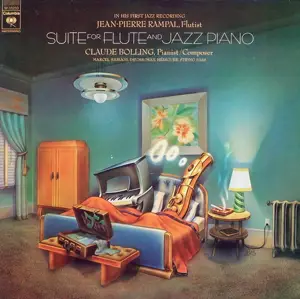
Premiere of Claude Bolling’s Suite for Flute and Jazz Piano Trio
Claude Bolling’s Suite for Flute and Jazz Piano Trio is a landmark composition that merges the worlds of classical music and jazz, creating a unique crossover genre that has captivated listeners since its release. Composed in 1973 and gaining widespread attention in 1975, the suite was written for the legendary flutist Jean-Pierre Rampal. It stands as a significant example of how two seemingly distinct musical traditions can be harmoniously blended.
Premiere Date and Performers
The Suite for Flute and Jazz Piano Trio was first recorded and released on July 16, 1975.
The recording featured:
Jean-Pierre Rampal on flute, whose classical expertise and emotive playing brought the suite to life.
Claude Bolling on piano, the composer of the work, who infused it with jazz rhythms and improvisational flair.
Guy Pedersen on double bass, adding depth and rhythmic support.
Marcel Sabiani on drums, contributing dynamic energy and drive to the piece.
Structure and Musical Content
The suite is structured into seven movements, each blending classical forms with jazz idioms:
1. Baroque and Blue: This opening movement sets the tone for the suite, combining the elegance of Baroque music with the bluesy, laid-back feel of jazz. The movement features a graceful flute melody that intertwines with jazz piano riffs, creating a seamless fusion of the two styles.
2. Sentimentale: A slower, more lyrical movement that allows the flute to explore its expressive range. The mood is introspective and emotional, with the piano providing a gentle, harmonic backdrop.
3. Javanaise: This movement introduces a lively, dance-like rhythm, inspired by the Javanese gamelan music, but filtered through a jazz lens. The flute plays playful, rhythmic figures, while the piano and rhythm section keep the groove moving.
4. Fugace: A brief and energetic movement, this piece features intricate interplay between the flute and piano, reminiscent of a fugue but with the spontaneous twists of jazz improvisation.
5. Irlandaise: Drawing on Irish folk music, this movement has a lilting, pastoral feel. The flute’s melody is bright and carefree, while the piano and rhythm section provide a supportive and rhythmic undercurrent.
6. Versatile: This movement is dynamic and lively, with rapid exchanges between the flute and the piano. The music shifts through various moods and styles, showcasing the versatility of both the performers and the composition itself.
7. Veloce: The suite concludes with a fast-paced and virtuosic movement. The flute and piano engage in a spirited dialogue, with complex rhythms and rapid-fire exchanges, bringing the suite to an exhilarating close.
Importance and Legacy
The Suite for Flute and Jazz Piano Trio was an immediate success, staying on the Billboard classical charts for an unprecedented 530 weeks. Its appeal lay in its ability to bridge the gap between classical music lovers and jazz enthusiasts, offering a fresh and innovative listening experience.
The collaboration between Bolling and Rampal not only highlighted the technical brilliance of the performers but also set a precedent for future crossover works. The suite remains a beloved piece in the repertoires of both classical and jazz musicians, celebrated for its ability to seamlessly blend two distinct musical traditions. Its premiere and subsequent recordings have left a lasting impact on the music world, inspiring countless musicians to explore the possibilities of genre fusion.
Bolling’s Suite for Flute and Jazz Piano Trio continues to be performed and recorded, a testament to its enduring appeal and the groundbreaking vision of its composer and performers.
Premiere of Claude Bolling’s Suite for Flute and Jazz Piano Trio

